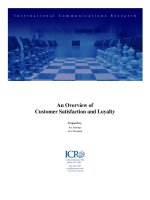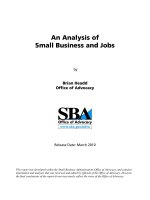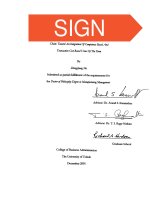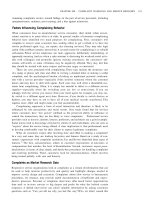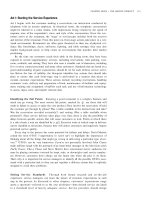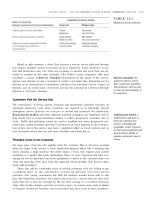INTERNATIONAL ASSIGNMENTS An Integration of Strategy, Research, and Practice ppt
Bạn đang xem bản rút gọn của tài liệu. Xem và tải ngay bản đầy đủ của tài liệu tại đây (15.27 MB, 302 trang )
INTERNATIONAL
ASSIGNMENTS
An
Integration
of
Strategy,
Research,
and
Practice
This page intentionally left blank
INTERNATIONAL
ASSIGNMENTS
An
Integration
of
Strategy,
Research,
and
Practice
Linda
K.
Stroh
Loyola University Chicago
J.
Stewart
Black
Center
for
Global Assignments
Mark
E.
Mendenhall
The
University
of
Tennessee
at
Chattanooga
Hal
B.
Gregersen
Brigham
Young
University
LAWRENCE ERLBAUM ASSOCIATES, PUBLISHERS
2005 Mahwah,
New
Jersey London
Copyright
©
2005
by
Lawrence Erlbaum Associates, Inc.
All
rights reserved.
No
part
of
this book
may be
reproduced
in
any
form,
by
photostat, microform, retrieval system,
or any
other
means, without
the
prior written permission
of the
publisher.
Lawrence Erlbaum Associates, Inc., Publishers
10
Industrial Avenue
Mahwah,
New
Jersey 07430
Cover design
by
Sean
Trane Sciarrone
Library
of
Congress
Cataloging-in-Publication Data
International assignments
: an
integration
of
strategy, research,
and
practice
/
Linda
K.
Stroh
[et
al.].
p. cm.
Includes bibliographical references
and
index.
ISBN
0-8058-5049-X (alk. paper)
—
ISBN
0-8058-5050-3 (alk. paper)
1.
Executives—Training
of. 2.
Leadership—Study
and
teaching.
3.
International
business enterprises—Employees—Training.
4.
International business enterprises—
Personnel management.
5.
Cross-cultural orientation.
I.
Stroh, Linda
K.
HD30.4.I574 2004
658.4'07—dc22
2004050610
CIP
Books
published
by
Lawrence Erlbaum Associates
are
printed
on
acid-free paper,
and
their bindings
are
chosen
for
strength
and
durability.
Printed
in the
United States
of
America
10
987654321
Contents
Foreword
vii
Preface
xi
About
the
Authors
xv
I
INTRODUCTION
1
1 The
Strategic Roles
of
International Assignments
in
Globalization
3
2 The
Process
of
Cross-Cultural Adjustment
29
II
BEFORE
THE
ASSIGNMENT
47
3
Selecting: Identifying Candidates With Global
Leadership Potential
49
4
Training: Helping People Learn
to Do the
Right Things
80
v
vi CONTENTS
III
DURING
THE
ASSIGNMENT
97
5
Adjusting: Developing
New
Mental Road Maps
and
Cultural Skills
99
6
Integrating: Balancing Multiple Allegiances
120
7
Appraising: Determining
if
People
Are
Doing
the
Right Things
144
8
Rewarding: Compensation
and
Pay
171
IV
AFTER
THE
ASSIGNMENT
187
9
Repatriating: Helping People
Readjust
and
Perform
189
10
Retaining: Utilizing
the
Experienced Global Manager
218
11
Managing
the
Entire Global Assignment Cycle:
Establishing Best Practices
235
References
257
Author Index
265
Subject Index
269
Foreword
Although
the
authors
of
this book
and I
approach
the
strategic challenges
of
glob-
alization
from
different
perspectives, we've come
to a
similar conclusion: that
the
"people"
imperative
is
often
overlooked when companies decide
to
enter
new
countries
or
world regions. Stroh, Black, Mendenhall,
and
Gregersen base their
assertion
on
extensive research
and
practice; mine
is the
product
of
more than
30
years
in
corporate leadership roles—the last
two
decades
of
which have included
positions with substantial exposure
to the
global marketplace.
It
is
stunning
to
think just
how
much
the
world
of
commerce
has
changed dur-
ing
that time. Many
of our
most cherished business paradigms have been
forever
altered
by the
impact offerees such
as
improved communications
and
transporta-
tion
technologies
and
borderless
trade
policies.
When
we
speak
today
of the
"Big
Three"
automakers
in the
United States,
for
example,
we
must remember that
one
of
those—DaimlerChrysler—is
now
controlled
by
German ownership;
and we
must
recognize that
in any
given month,
a
Japanese
firm
with U.S.
manufacturing
facilities
is
likely
to be one of the top
three.
As
noted
by
Stroh
et
al., globalization
has
become
a
fact
of
business
life.
It is
inevitable
in an era
when
the
corporate customers that many companies serve
are
positioning themselves
to
become global players.
A
company
can no
longer
af-
ford
to
focus
on a
single geographic market—not
if it
expects
to
earn business
contracts
from
corporations
and
conglomerates that
are
aggressively developing
their business opportunities
on a
global stage. Such customers
won't
wait
for
their
traditional suppliers
to
catch
up.
Instead, they will turn
to new
suppliers, suppliers
that
can in
fact
help produce
and
distribute their products
and
services
in the
mar-
kets
they
want
to
enter.
vii
viii
FOREWORD
Nor are
customer demands
the
only
significant
force
driving
the
trend toward
globalization today. Foreign competitors play
a key
role, too.
As
industries con-
solidate
in
Europe, North America,
and
Asia,
we
have seen time
and
again
how
the
largest players
in
each
of
those markets begin
to
look
offshore
for
their next
big
growth opportunities. Precisely because these competitors have developed
world-class scale
and
processes
in
their home markets, they
can
represent
a
signif-
icant
threat
to
companies
in
other world regions. This
is
especially true when local
companies
fail
to
recognize
the
threat.
If
local companies
do not
move aggres-
sively
to
become world-class competitors themselves, their domestic markets
can
evaporate
in a
heartbeat.
So
perhaps
the first
important lesson
of the
past
20
years
is
that global presence
has
become
a
strategic imperative
for
major
companies today.
It is not
merely
a
"nice-to-have"
option
for
stimulating growth.
It is a
"must-have" capability
for
ensuring
the
company's long-term survival.
Both
the
authors
of
this book
and I
know this lesson
has
important implications
for
a
company's leadership.
The
reason
is
simple: Leadership development
is—
and
always
has
been—one
of the
chief executive
officer's
(CEO's)
most impor-
tant responsibilities. Preparing
the
next generation
of
company leaders
is
every
bit
as
critical
as
producing great products
or
developing
an
effective
strategic plan
when
it
comes
to
ensuring
a
company's
future
competitiveness. Today, that
means preparing leaders
who can
understand
and
operate
effectively
in a
global
business environment.
All
too
often,
however, this responsibility
is
overlooked.
A
survey
of
business
literature over
the
past couple
of
decades will reveal
no
shortage
of
material about
strategies
for
globalization:
how to
globalize products,
how to
build
a
global sup-
ply
chain,
how to
manage projects across continents
and
time zones,
and so on.
However, comparatively little
information
exists
on the
subject
of
developing
a
management group that
can
effectively
accomplish these things.
I
believe that
is
because
few
business experts understand
how to do
it—or even recognize that
it
ought
to be a
priority.
It
is
hard work
to
develop
a
cadre
of
globally competent leaders
and
managers.
It
takes planning
and
commitment.
In
fact,
as
noted
in
this book,
it has to
begin
very
early
in the
careers
of
fast-track
managers
so
that they have
the
chance
to de-
velop
a
broad
base
of
cross-cultural
experience
and
insight
before they
are
called
to
take
on
vital leadership roles
in
overseas operations.
The CEO
must
set the
stage
for all
this
to
happen
by
insisting that
the
company's
leadership develop-
ment
process
includes
a
component
for
globalizing executives. Nothing short
of
such
a
commitment will produce
the
pool
of
candidates necessary
for the
com-
pany
to
succeed
as a
truly global enterprise.
In
fact,
I
believe that companies ought
to do
even more than develop
effective
strategies
for
globalizing their next generation
of
leaders. Tremendous benefits
can
be
gained
by
taking
the
process
a
step
further—by
globalizing
the
company's
entire culture
so
that
its
vision, values,
and
standards
are
understood
and
practiced
FOREWORD ix
in
every
one of its
markets everywhere
in the
world. Once again,
the
insight
gained
from
my
experience
is
consistent with
the
content
of
this Stroh
et al.
book.
That
is the
second important lesson
to be
drawn
from
the
past
20
years. Com-
panies that hope
to
succeed
in
other countries
and
regions must make
a
global
commitment
to
their vision, values,
and
standards.
In
case
after
case,
major
com-
panies have learned that
it is
impossible
to run a
successful business
in a
foreign
market
by
remote control. They cannot compromise
on the
quality
of the
people
they send there
or on the
people they hire there. They cannot compromise
on the
thoroughness
of
their planning, either—or
on the
resources they
are
willing
to
commit
to the
development
of the
market.
This
is not to say the
solution
is to
transplant
a set of
home-country business
rules
in
overseas operations.
On the
contrary; consistent with this
book's
perspec-
tive, global companies must demonstrate
a
deep
and
profound respect
for the
cus-
toms, laws,
and
dynamics
of
each market
in
which they operate. However, what
they
can
transplant—what they must transplant—is
a
clear sense
of
their corpo-
rate vision, values,
and
standards
of
excellence.
It
is
absolutely essential that
a
company's leaders establish this common
ground
for
employees
in
every market around
the
world. Employees have
to
clearly
understand
the
global
strategy
and
their
role
in
executing
that
strategy.
Just
as
important, they have
to
understand
how
they
are
expected
to
behave
as
mem-
bers
of a
global team—how people
are to be
treated
and how the
work gets done.
When
values such
as
these
are
developed
and
shared across
the
enterprise,
it has
an
energizing
effect
on the
entire organization.
In a
very real sense,
a
strong cor-
porate culture
can
help
to
offset
the
distance between
and
among
far-flung
opera-
tions around
the
world.
It can
accelerate
the
company's success, too—by ensuring
that
the
employees
of
every work team
and
every business unit
are
pulling
in the
same direction.
What
we
come
to,
then,
is a
full
appreciation
of the
people imperative identi-
fied
in
this
book.
Experience shows that
any
globalization initiative
is
destined
to
produce disappointing results unless
it
includes
a
strong
focus
on
developing
ef-
fective
global managers
and
leaders. That
is
what makes
the
content
of
this book
critically important:
It
identifies leadership that every executive would
do
well
to
heed.
—William
L.
Davis
President,
Chairman
and
Chief
Executive
Officer
RR
Donnelley
November,
2003
This page intentionally left blank
Preface
That
rapid globalization
is
taking place
in
businesses around
the
world
is
beyond
dispute.
If
multinational
firms are to
prosper
now and in the
future,
their managers
must
be
able
to
function
in a
global context—formulating
and
implementing strat-
egies,
inventing
and
utilizing
technologies,
and
creating
and
coordinating infor-
mation. International assignments
are the
single most
powerful
means
for
devel-
oping
future
global leaders.
Although
increasing numbers
of
corporations recognize
the
value
of
develop-
ing
global leaders,
all too
often
the
business objectives
of
international assign-
ments
are not
being met.
In
short,
firms
are not
getting good returns
on the
time
and
expense they invest
in
international assignments. Uncompleted assignments,
poor
performance,
and
high rates
of
turnover
after
repatriation
are
common
and
cost even moderately sized multinational corporations tens
of
millions
of
dollars
each
year. Additionally, individuals
are not
getting good returns
on
their invest-
ment
in
accepting
international assignments. Seven
out of 10
managers believe
that their time spent
on an
international assignment
had a
negative impact
on
their
career.
The
reality
is
that international assignments
are
stressful
and
that stress
shows
up in
substance abuse, strained
and
broken marriages,
and
other
family
problems.
In
addition
to
studying international assignments,
we, as the
authors
of
this
book,
all
have experienced
and
seen
firsthand the
significant losses
and
profits
to
organizations
and to
individuals that result when international assignments
are
poorly
or
well designed. These experiences have given
us an
understanding
of the
issues
as
well
as an
intense motivation
to
provide
a
systematic guide
for
construct-
ing
effective
international assignment
systems—systems
that
achieve
critical
competitive
results today
and
develop
the
global leaders
of
tomorrow.
xi
xii
PREFACE
Although
firms
have been sending employees
on
international assignments
for
decades, systematic understanding
is
sorely lacking
in
such critical aspects
of the
assignment process
as the
selection process;
the
training required; factors that
af-
fect
adjustment, performance,
and
commitment;
and how to
retain
and
capitalize
on
international experience once employees return home. Although there
has
been increased scholarly research
on
international assignments, much
of it is
tucked away
in
academic journals
and is
unknown
to the
very executives
who
would
most practically
benefit
from
that knowledge.
We
have written this book
with
the
hope that
by
learning
the
best practices
and
latest research findings
on in-
ternational assignments, both
the
individuals embarking
on
international assign-
ments
and the
organizations sending them will experience more positive results.
This book
was
written
from
a
North American multinational corporation
fo-
cus; however, many examples
are
used
from
Finnish, Japanese, Brazilian, Malay-
sian,
and
other European, Asian,
and
Southeast Asian experiences
and
research.
This book would
be
most appropriate
for
managers working
in
multinational
firms who
deal with international assignees. This book would also
be
excellent
for
advanced
undergraduate
and
graduate students
in
MBA, Human Resources,
Or-
ganizational Development, Industrial Organizational Psychology, Organizational
Behavior,
or
Cross-Cultural studies programs. This book accesses much
informa-
tion that
was
used
in an
earlier book
by the
same authors.
The
title
of
that
book
is
Globalizing
People
Through
International Assignments
(1999).
AUDIENCE
This book
is
written primarily
for
executives whose
focus
includes
the
global
economy
and the
strategic role
of
people
in
achieving international competitive-
ness. This includes chief executive
officers,
line managers,
and
especially human
resource management executives.
After
reading this book, executives should have
a
sophisticated
but
practical understanding
of the
strategic roles
of
international
assignments
as
well
as of the
complete cycle
of
these assignments.
Each chapter
has
four
objectives:
(a) to
examine
a
specific
problem concerning
international assignments,
(b) to
explain
the
underlying principles
for
understand-
ing
the
problem,
(c) to
provide
a framework for
analyzing
the
issue,
and (d) to
present recommendations
for
executives
to
follow
in
redesigning
or
enhancing
their current systems.
It
will also serve
as a
textbook
for
courses
on
International Human Resources.
OVERVIEW
OF
CONTENTS
The
book covers every
major
aspect
or
stage
of
international assignments. Chap-
ter
1
defines
the
strategic roles that international assignments
can
play
and
dis-
cusses
how
these roles need
to be
adjusted,
depending
on the
firm's particular
PREFACE
xiii
stage
of
internationalization. Chapter
2
explores
the
process
of
cross-cultural
ad-
justment, critical
for
effectively
working
and
living
in
foreign cultures. Chapter
3
examines issues pertaining
to
selecting people
for
international
assignments,
ad-
dressing both
who
should
be
selected
and how
they should
be
chosen. Chapter
4
focuses
on the
challenge
of
training people
so
that they perform
effectively
while
overseas. Specifically,
the
chapter provides
a
framework
for
firms
so
that they
do
not
over-
or
underinvest
in
these training needs. Chapter
5
focuses
on the
factors
that
affect
successful cross-cultural adjustment
and
describes ways
firms
can fa-
cilitate
the
adjustment process. Chapter
6
provides pioneering insights into
the dy-
namics
of
dual allegiance
(to the
parent
firm and the
local foreign operation) that
occurs among international managers
and
discusses
how firms can
foster
"dual
citizens,"
or
employees with dual allegiance
to
both their home-country operation
and
local unit. Chapter
7
examines
the
difficulties
of
appraising employees while
they
are on
foreign assignments
and
provides
a
model
of how
this
can be
done
ef-
fectively.
Chapter
8
explores
the
problems most
firms
face
regarding
the
high
compensation
costs
of
maintaining employees
who
work abroad
and
outlines
a
means
of
significantly reducing those costs while motivating employees
to
accept
and perform well
in
international assignments. Chapter
9
unravels
the
process
of
coming home, exploring
the
factors that
affect
repatriation adjustment
and job
performance.
It
points
to
specific steps
firms can
take
to
facilitate repatriation
ad-
justment
and
performance. Chapter
10
explains
the
factors that determine whether
high-performing
repatriated managers will stay with
the firm or
look
for
greener
pastures elsewhere. Included
are
recommendations
for
retaining
and
utilizing
high-performing
returning managers
and
executives. Finally, chapter
11
summa-
rizes
and
integrates critical elements
of the
international assignment cycle.
It
also
describes
firms
that represent some
of the
best practices
in
selection, training,
ap-
praisal, compensation,
and
repatriation,
as
well
as
security issues companies must
address
now
more than ever.
ACKNOWLEDGMENTS
There
are
many people
to
whom
we owe
thanks. First,
we
thank
our
families
for
their support
and
understanding.
We
thank them
for
their willingness
to
live
in
such places
as
Japan, Finland, Switzerland,
and
Canada.
We
also thank them
for
making international travel
a
possibility,
as
they sometimes travel with
us, and for
maintaining
the
home
front
when
we are
apart.
We are
also
thankful
to the
Fortune®
500
executives
who
have written
the
"From
the
Front
Line"
boxes
for
this book.
In
particular,
we
thank
Raj
Tatta
and
John Neylon
of
PriceWaterhouseCoopers,
an
anonymous contributor
from
a fi-
nancial
services
company, Maureen Ausura
from
ADM,
Jim
Pilarski
from
Marriott International, Kevin Gazarra
from
Intel, Jenny
Li
from
Sony Pictures
Entertainment, Dick Bahner
from
R
Bahner International, Kerry Weinger
from
xiv
PREFACE
Baker
and
McKenzie, Marie Howard
from
The
Procter
&
Gamble Company,
John
Murphy
from
Motorola,
Amy
Glynn
from
Dow
Jones
&
Company,
and
Shlomo Ben-Hur
and
Kerstin Boecker
from
DaimlerChrysler. Their time
and
contributions
have
set
this
book apart
from
others.
We
are
also
grateful
to
colleagues
at
Loyola University Chicago; University
of
Tennessee, Chattanooga;
The
University
of
Michigan;
and
Brigham Young Uni-
versity.
In
particular,
we
thank Stacey Bogumil, Kelly Chew, Antoinette
Cromartie,
and
Brooke Zahara
who
collected company data
for
chapter
3
(this
volume)
as
part
of a
group research project they
did for a
master's level
class
in
the
Human Resources
&
Industrial Relations program (HRIR 443)
at
Loyola Uni-
versity Chicago.
In
addition,
we
thank Anne
Duffy,
our
Lawrence Erlbaum Associates, Inc.
project
director,
for her
constant support
and
encouragement.
It was a
real treat
working
with Anne. Finally
we
thank Erica
Fox for her
expert
research
and
edit-
ing
skills. This book could
not
have happened without
Erica's
major
contribution.
Linda
K.
Stroh
Loyola
University
Chicago
J.
Stewart Black
Center
for
Global Assignments
Mark
E.
Mendenhall
University
of
Tennessee, Chattanooga
Hal
B.
Gregersen
Brigham
Young
University
About
the
Authors
Linda
K.
Stroh
is a
Loyola University Faculty Scholar
and
Professor
of
Human
Resources
&
Industrial Relations
at the
Graduate School
of
Business, Loyola Uni-
versity Chicago. Stroh received
her PhD
from
Northwestern University
in
Human
Development.
She
also
has a
Postdoctorate
in
Organization Behavior
from
North-
western's Kellogg Graduate School
of
Management.
She
received
her BA
from
McGill University
in
Montreal, Quebec, Canada
and her MA
from
Concordia
University also
in
Montreal.
Stroh
has
taught
and
published over
100
articles, books,
and
technical reports
on
issues related
to
domestic
and
international organizational behavior issues.
Linda's
work
can be
found
in
journals such
as
Strategic Management Journal,
Journal
of
Applied
Psychology,
Personnel
Psychology,
Academy
of
Management
Journal,
Journal
of
Vocational Behavior, International Journal
of
Human
Re-
source Management, Journal
of
Organizational Behavior, Journal
of
Manage-
ment
Education, Sloan Management Review, Human Resource Management
Journal,
Journal
of
World
Business,
and
various other journals.
In
addition
to
this
book, Stroh
is
coauthor
of two
other books, Globalizing People Through Interna-
tional
Assignments
and
Organizational Behavior:
A
Management Challenge.
Stroh
was
honored
at the
2000
Academy
of
Management Meeting with
the
Sage publications research scholar award.
She was
also named
the
Graduate Fac-
ulty Member
of the
Year
at
Loyola University Chicago
(2000)
and was
selected
as
a
Loyola University Faculty Scholar
in
2001.
The
Wall
Street Journal,
The New
York
Times,
The
Washington
Post,
The
Chicago Tribune, Fortune, Newsweek,
U.S.
News
and
World
Report,
and
Business
Week
as
well
as
various
other
news
and
popular press outlets have cited
Stroh's
work.
Stroh's
research
has
also been
featured
several times
on NBC
Nightly
News with
Tom
Brokaw
and
CNN.
xv
xvi
ABOUT
THE
AUTHORS
In
addition
to her
teaching
and
research, Stroh serves
as the
Academic Adviser
for
the
International Personnel Association
(an
association
of 60 of the top 100
multinational
companies
in the
United States
and
Canada).
She is
also
a
past
Chair
of the
Careers Division
for the
Academy
of
Management. Linda currently
serves
on the
editorial review board
for the
Journal
of
Applied
Psychology, Jour-
nal
of
World
Business, Journal
of
Vocational
Behavior,
and
Organizational Anal-
ysis.
She
also served
on
SHRM's International Human Resources Task Force.
Stroh
has
consulted with over
40
Fortune
500
organizations regarding such
is-
sues
as
motivation, leadership, change management, problem solving, strategic
planning, diversity, international assignments,
and
cross-cultural management.
Linda
and her
husband, Greg, have married children: Angie
and Joe
Gittleman
and
Brad
and
Brandy Stroh. They
are
awaiting
their
first
grandchild
in
July.
J.
Stewart Black
is the
Managing Director
of the
Global Leadership Institute.
He
is
also Executive Director
of the
Asia
Pacific
Human Resource Partnership
for the
University
of
Michigan
and a
Professor
of
Business Administration
for the
Busi-
ness
School.
Black received
his
undergraduate degree
in
Psychology
and
English
from
Brigham Young University where
he
graduated with honors.
He
earned
his
mas-
ter's
degree
from
the
Business School
at
Brigham Young University where
he
was on the
dean's
list
and
graduated with distinction.
After
graduation,
he
worked
for
a
Japanese consulting
firm
where
he
eventually held
the
position
of
managing
director. Black returned
to the
United States
and
received
his PhD
from
the
Uni-
versity
of
California, Irvine.
He
then took
a
position
as
assistant professor
at the
Amos Tuck School
of
Business Administration, Dartmouth College
and was
later
promoted
to
associate professor.
After
5
years
at
Dartmouth
College,
Black
ac-
cepted
a
position
as
associate professor
of
international management
at
Thunder-
bird
(The American Graduate School
of
International Management). Black also
served
as the
director
of the
Thunderbird Japan Campus
and
later
as the
Associate
Vice President
for
Thunderbird Executive Education. Prior
to
leaving Thunder-
bird
to
join
the
University
of
Michigan, Black
was
promoted
to
full
professor with
tenure.
Black
is a
leading instructor
and
scholar
in
strategic change, globalization,
leadership,
and
international human resource management.
His
research
and
con-
sulting focuses
on the
areas
of
change, global leadership, strategic human
re-
source management, international assignments,
and
cross-cultural management.
Black
has
traveled extensively throughout Europe
and
Asia.
In
addition,
he has
lived
and
worked
in
Japan
for
over
4
years
and
speaks Japanese
fluently. He has
been
a
visiting professor
at
International University
of
Japan
on
three
different
oc-
casions.
Black
has
consulted with
and
done seminars
for a
variety
of
international
firms
in
the
areas
of
global leadership
and
international human resource management
including American Express, Black
&
Decker,
The
Boeing Company, Brunswick,
ABOUT
THE
AUTHORS
xvii
Dofasco,
ExxonMobil, General Motors, IBM,
The
Kellogg Company, Motorola,
NASA, Solar Turbines, TRW, Honda Motors, Isuzu
Motors,
Kawasaki Shipping,
Kawasaki Steel, Nissan Motors, Nihon Unisys, Sunkyong,
and
TDK.
Black
is
also
a
coauthor
of
eight books including Leading Strategic Change:
Breaking
Through
the
Brain Barrier; Global Explorers:
The
Next Generation
of
Leader; Globalizing People
Through
International Assignments;
So
You're
Going
Overseas:
A
Handbook
for
Personal
and
Professional
Success; Manage-
ment: Meeting
New
Challenges;
and
International Business Environments.
He is
the
author
of
over
50
articles
in the
area
of
international human resource manage-
ment that have appeared
in
both managerial
and
academic publications: Business
Week,
The
Wall
Street Journal, Fortune,
Workforce,
International Business,
Mo-
bility,
Personnel, Academy
of
Management Review, Academy
of
Management
Journal,
Human Resource Management,
Group
&
Organization Studies, Interna-
tional
Journal
of
Intercultural Relations,
Asia-Pacific
Journal
of
Management,
Journal
of
International Business Studies, Academy
of
Management
Journal,
and
Human
Relations.
He has
also made over
40
presentations
at
professional meet-
ings
in the
United States
and
throughout
the
world.
He
is a
member
of the
Academy
of
Management
and has
served
on the
Execu-
tive Committee
of the
International Management Division.
He has
served
as
Edi-
tor of the
Journal
of
International Management
and an
Editorial Board Member
of the
Academy
of
Management
Review.
He has
also served
as a
reviewer
for Ad-
ministrative Science
Quarterly,
Journal
of
International Business Studies,
and
Academy
of
Management Journal.
Mark
E.
Mendenhall holds
the J.
Burton Frierson Chair
of
Excellence
in
Busi-
ness Leadership
at the
University
of
Tennessee, Chattanooga.
He
received
his BS
degree (1980)
in
psychology
and his PhD
degree
(1983)
in
social psychology,
both
from
Brigham Young University.
In
1998,
he
held
the
Ludwig Erhard
Stiftungsprofessur Endowed Chair
at the
University
of
Bayreuth (Germany),
and
since 1999,
he has
been
a
visiting professor
on the
faculty
of the
Europa Institute
at
the
University
of
Saarland
(Germany).
Mendenhall
is an
internationally recognized scholar
in the
field
of
interna-
tional human resource management,
his
areas
of
expertise being
the
cross-cultural
adjustment
of
expatriate managers
and
global leadership development.
His
other
research
and
consulting interests
are in the
areas
of
leadership
and
organizational
change
and the
nonlinear dynamics
of
organizational systems.
He has
authored
the
following books: (with
G.
Stahl) Managing Culture
and
Human Resources
in
Mergers
and
Acquisitions (forthcoming, Stanford Univer-
sity
Press);
Blackwell Handbook
of
Global Management:
A
Guide
to
Managing
Complexity
(with
H.
Lane,
M.
Maznevski,
& J.
McNett, Blackwell); Developing
Global
Business Leaders: Policies, Processes,
and
Innovations
(2001,
with
T.
Kuhlmann
and G.
Stahl; Quorum); Readings
and
Cases
in
International Human
Resource Management
(2000,
3rd
ed., South-Western), Developing People
xviii
ABOUT
THE
AUTHORS
Through
International Assignments (1999, with
J.
Stewart Black,
Hal
Gregersen,
and
Linda Stroh; Addison-Wesley); Cases
in
International Organizational
Be-
havior
(1999,
with Gary Oddou, Blackwell); Global Management
(1995,
Blackwell; with
D.
Ricks
and B. J.
Punnett); Global Assignments:
Successfully
Expatriating
and
Repatriating International Managers (1992, Jossey-Bass; with
J.
Stewart Black
and Hal
Gregersen);
and
Readings
and
Cases
in
International
Human
Resource Management (1991,2nd ed., with
G.
Oddou, South-Western).
He
has
published numerous research articles that have appeared
in
such
jour-
nals
as
Sloan Management Review, Academy
of
Management
Review, Journal
of
International
Business Studies, Organizational Dynamics, Management Interna-
tional
Review, Columbia Journal
of
World
Business, Human Relations, Organi-
zational Dynamics, Journal
of
Management Inquiry, Journal
of
Management
History,
Human Resource Management Review, Handbook
of
Intercultural
Training,
American Behavioral Scientist, Human Resource Management,
Group
and
Organization Studies, International Journal
of
Management,
Business Hori-
zons, Human Resource Development Quarterly, Journal
of
Management
Educa-
tion,
Asia-Pacific
Journal
of
Management,
Training
and
Development Journal,
International
Journal
of
Intercultural Relations, Journal
of
Social Psychology,
Journal
of
European Industrial
Training,
and
Teaching
of
Psychology.
He
is
active
in the
Academy
of
Management
and is
currently past president
of
the
International Division
of
that organization. Mendenhall actively consults
and
trains
in the
areas
of
global leadership
and
cross-cultural management. Some
of
the
companies
he has
worked with include IBM-Asia Pacific, IBM-Japan,
Na-
tional
Aeronautic
and
Space Administration (NASA), Boeing, Monsanto, J.C.
Bamford
(JCB),
The
Dixie Group,
and
Japan
Air
Lines Corporate Academy.
Mendenhall
has
traveled widely
and has
lived overseas
for 9
years (New Zealand,
Japan, Switzerland,
and
Germany).
He and his
wife
Janet have
four
children—
Anthony, Nicole, Alexis,
and
Zachary. Anthony
is
currently serving
a
2-year mis-
sionary stint
in the
West Indies
and
currently
is
living
and
working
in
Guyana.
Hal
B.
Gregersen
is the
Donald
L.
Staheli Professor
of
Global Leadership
in the
Marriott School
at
Brigham Young University. Gregersen taught previously
in the
Amos Tuck School
of
Business Administration
at
Dartmouth College, Pennsylva-
nia
State University, Thunderbird, Helsinki School
of
Economics,
and
completed
a
Fulbright Fellowship
at the
Turku School
of
Economics
in
Finland.
He
also
teaches
in
executive education programs
for
numerous universities (University
of
Michigan, Helsinki School
of
Economics,
the
Fletcher School
of Law and
Diplo-
macy
at
Tufts
University,
and
Thunderbird)
and
companies (Black
&
Decker,
Cemex, EDS, IBM, Intel, Lockheed Martin, Marriott International,
and Sun
Microsystems). Gregersen received
a PhD in
Business Administration
from
the
University
of
California, Irvine.
In
1996,
he
received
the
Ascendant Scholar
Award
from
the
Western Academy
of
Management. Gregersen
is
also
the
recipi-
ent
of
several outstanding teacher awards.
ABOUT
THE
AUTHORS
xix
Gregersen's
primary
research,
teaching,
and
consulting
interests
focus
on im-
plementing global strategies
and
developing executive leadership capability.
He
is the
author
of
seven books
and
more than
50
articles, book chapters,
and
cases
on
these
topics
and has
published
in top
business
journals such
as
Harvard Busi-
ness Review,
Shan
Management Review, Academy
of
Management Journal,
Journal
of
International Business Studies, Journal
of
International Management,
Journal
of
Applied Psychology,
and
Journal
of
Management.
Gregersen recently completed
a
major
international research project
for a new
book, Leading Strategic Change: Breaking
Through
the
Brain Barrier (with
J. S.
Black,
Financial
Times/Prentice
Hall,
2003).
Gregersen
is
also
the
coauthor
of
Global
Explorers:
The
Next Generation
of
Leaders
(with
J. S.
Black
& A.
Morri-
son, Routledge, 1999),
a
book based
on
in-depth interviews
of
exemplar global
leaders
and how
leading
multinationals develop
them.
In
addition,
Gregersen
coauthored
the So You 're
Going Overseas
and So You 're
Coming Home books
(with
J. S.
Black, Global Business),
a
series
of
practical books
to
successfully
guide
employees
and
their families through
the
entire
international
assignment
cycle. Gregersen
has
appeared
on
CNNfn
to
discuss
his
research
on
global leader-
ship
and has
been cited
in
numerous publications such
as
Across
the
Board, Busi-
ness
Week,
Executive Excellence, Fortune,
Industry
Week,
Investor's Daily,
Los
Angeles Times, U.S. News
and
World
Report,
and The
Wall
Street Journal.
Gregersen consults with
a
variety
of
North American, European,
and
Asian
firms
(for example,
Ameritech,
Intel,
LG
Group, Marriott International,
and
Nokia)
to
formulate
and
implement successful global
strategies.
He
regularly
de-
livers keynote speeches
on
international topics
for
firms
and
professional associa-
tions
around
the
world.
Gregersen
and his
family
have lived several years
in
Finland.
His
wife Suzi,
his
late
wife
Ann,
and he
have eight children—Kancie, Matt, Emilee, Ryan,
Kourtnie, Amber, Jordon,
and
Brooke.
This page intentionally left blank
PART
I
INTRODUCTION
This page intentionally left blank
The
Strategic
Roles
of
International
Assignments
in
Globalization
Why
do
some
firms
compete successfully
in the
world marketplace
and
others
lose
or
fail
to
gain
a
global advantage? Some analysts argue that strategy
is the
key:
The
winners
are the
ones with
the right
game plans. Others contend that
the
key
to
success
is to
develop
the right
corporate structure.
Still
others claim that
meeting
the
challenges
of
global business requires technological innovation.
We
think that
the key to
success
is
developing global leaders. Whether those
people recognize
or
miss global threats
or
opportunities
is a
function
of
their
ex-
perience
and
perspective. Increasingly, research
is
supporting this observation.
For
example, recent research (Carpenter, Sanders,
&
Gregersen,
2000)
indicates
that U.S.
firms
headed
by
chief executive
officers
(CEOs)
with international
ex-
perience perform better than
firms
whose CEOs lack this experience. Having
em-
ployees with international experience also enhances
an
organization's competi-
tive advantage.
Support
for the
value companies place
on
global experience
is
also apparent
from
several recent executive appointments. Charles Perrin,
the CEO of
Avon,
was
chosen
in
large part because
of his
global experience
at
Duracell®. Similarly,
General
Motors
named Richard Waggoner president
and CEO
after
he
turned
around
the
company's
floundering
operations
in
South America.
As the
appoint-
ments
of
Waggoner, Perrin,
and
other executives demonstrate, organizations
are
increasingly recognizing
the
value
of
international experience
in
shaping global
leaders. Likewise, growing numbers
of
executives
identify
their international
ex-
perience
as the
single most
influential
force
in
their development
as
managers
(Carpenter
et
al., 2000).
International assignments
are
also
the
single most expensive per-person invest-
ment
a
company makes
in
globalizing
its
workforce,
and
unfortunately, most
3
CHAPTER
1
4
CHAPTER
1
firms
are
getting anemic returns
on
this investment.
To
improve their return, man-
agers must understand
the
best
practices, thinking,
and
scientific research
on in-
ternational assignments.
In
combination, this material
can
offer
a
sophisticated
yet
practical guide
for
maximizing
the
return
on
international assignments
and de-
veloping
effective
global leaders.
STRATEGIC
VALUE
OF
GLOBAL
ASSIGNMENTS
In
the
past, U.S.
firms
tended
not to use
global assignments
for
strategic purposes.
In
general,
people
were
sent
overseas
to
carry
out
specific
tasks
because
manage-
ment
felt
that
the
local talent
was not up to the
challenge. Because
of
this tactical
approach,
the
strategic implications
of the
assignment,
for the
company
and the
individual,
were
often
neglected.
In
contrast, leading companies today have
de-
veloped
a
more strategic tactic.
For
them, global assignments serve several impor-
tant
roles:
in
succession planning
and
leadership development;
in
coordination
and
control;
and in
technology, innovation,
and
information
exchange
and
dis-
semination.
Leadership
Development
and
Global
Assignments
One of the key
concerns
and
responsibilities
of
current CEOs
is
developing
future
CEOs
and
executives. Savvy CEOs know that their
company's
future
strategy
will
be no
better than
the
quality
of the
people
in the
organization.
For
example,
a
Beethoven concerto
may be
beautiful
and
powerful,
but you
would
not
want
it
played
by a
beginning piano student. Likewise,
in
today's
business environment,
it
is
madness
to
think
of
trying
to
formulate
or
implement
a
strategy without con-
sidering
the
global business environment
in
which
it is
expected
to
function.
The
"From
the
Front Lines"
for
this chapter
offers
one
executive's perspective
on the
need
to
develop global leaders.
Currently, most organizations have
a
serious shortage
of
global
leaders.
Con-
sequently,
all
companies need
to
make developing globally capable employees
a
top
priority. Fortunately, most human resource executives
do
recognize this.
For
example,
in a
survey
of 108
Fortune®
500
companies, senior executives cited
having
effective
global managers
as the top
priority
in
achieving international
success. When questioned, Jack Reichert,
a
former
CEO of
Brunswick Corpora-
tion, captured
the
importance
of
developing
future
global leaders:
Financial resources
are not the
problem.
We
have
the
money, products,
and
position
to be a
dominant global
player.
What
we
lack
are the
human
re-
sources.
We
just
don't
have enough people with
the
needed global leadership
capabilities.
